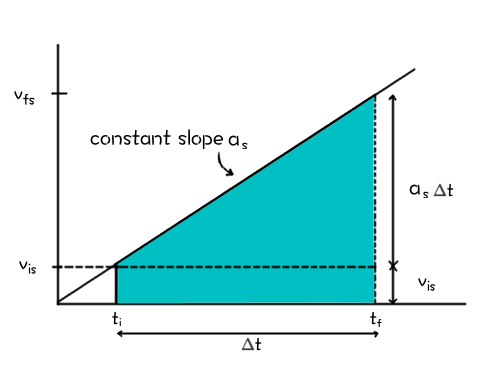Question #2e2cc
1 Answer
See below.
Explanation:
Kinematics is a branch of mechanics used to describe motion—without regard to what caused that motion (forces). Kinematic equations are used to mathematically describe the motion of an object (e.g. displacement, velocity, acceleration).
Consider an object whose acceleration
At the beginning of this interval,
Say we want to predict the object's final position
The object's velocity is changing because the object is accelerating . We can find the object's velocity
By definition:
#a_s=(Deltav_s)/(Deltat)=(v_(ts)-v_(is))/(Deltat)#
which is easily rearranged to give
#color(blue)(v_(fs)=v_(is)+a_sDeltat)#
The velocity-versus time graph is a straight line that starts at

The object's final position is
#s_f=s_i+"area under the curve " v_s " between " t_i " and " t_f#
The area under the curve can be subdivided into a rectangle of area
Adding these gives:
#color(blue)(s_f=s_i+v_(is)Deltat+1/2a(Deltat)^2)# where
#Deltat=t_f-t_i# is the elapsed time
The final kinematic equation for constant acceleration is first found by using our first equation (in blue) to write:
#Deltat=(v_(fs)-v_(is))/a_x#
Substituting that into our second (blue) equation, we get:
#s_f=s_i+v_(is)((v_(fs)-v_(is))/a_x)+1/2a_s((v_(fs)-v_(is))/a_x)^2#
With a bit of algebra, this is rearranged to read
#color(blue)((v_(fs))^2=(v_(is))^2+2a_sDeltas)# where
#Deltas=s_f-s_i# is the displacement
Hope that helps!

